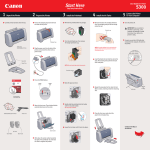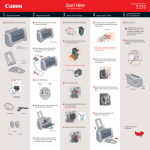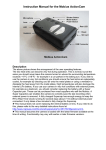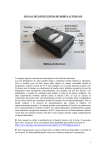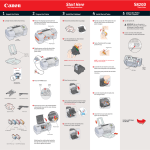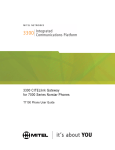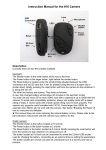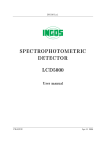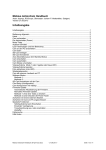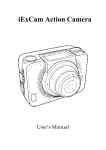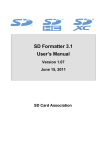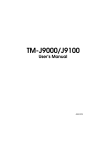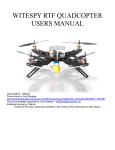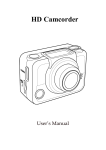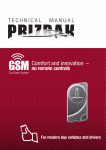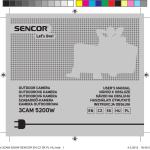Download Instruction Manual for the Mobius ActionCam
Transcript
Instruction Manual for the Mobius ActionCam Description The above picture shows the arrangement of the user operating features. The two heat sinks can become very hot during operation. This is normal, but all the same you should never leave the camera turned on where the surrounding temperature exceeds ~47°C (118°F) - for example in a car parked in the baking sun. If you wish to use the camera in very hot conditions you should ensure the heat sinks are adequately cooled, for example by directing cool air onto the metal plates or using a ventilator to dissipate the heat away from the metal plates. High temperatures will also damage the internal LiPo battery. If you use your camera in very hot conditions with external power, for example as a dashcam, you should consider replacing the battery with a Super Capacitor pair. These can be purchased from most suppliers who sell the Mobius. A Super Capacitor pair enables the camera to correctly save the last recording when external power is removed. A fully charged Supercap has enough energy to keep the RTC (Real Time Clock) running for a few days without external power. It only takes a few minutes to fully charge the Supercap. At the time of writing you may use any micro SD, micro SDHC or Micro SDXC card with a capacity of up to 64GB with this camera. Larger cards are most likely also supported but not yet available. To avoid card compatibility problems, always use quality cards with a speed rating of Class 4 or greater. The camera supports cards formatted with FAT32 or exFAT. Because of technical reasons, you cannot update the firmware if your card is formatted as exFAT. When using the In-Camera formatting routine (see below) cards with a capacity greater than 32GB will be formatted with exFAT. All other cards will be formatted as FAT32. Older operating systems, for example XP 64-Bit and Windows 2003, do not support exFAT file systems unless you install additional drivers. A list of exFAT drivers can be found at http://search.microsoft.com/en-us/DownloadResults.aspx?q=KB955704. ►This manual does not cover replacing the internal battery or lens. If you need to do this, please refer to the very detailed instructions found at http://www.rcgroups.com/forums/showpost.php?p=25170910&postcount=4. ►This manual assumes the camera is loaded with the latest firmware available at the time of writing. Functionality may vary with earlier or later firmware versions. Cables The camera requires a standard USB cable for charging or connecting to external battery packs for continuous recording. A standard USB cable is also used to connect the camera to the PC in order to set the parameters or access the camera as an external disk or webcam. A/V-out (or Video-Out) requires a special cable where pin #4 is shorted to pin #5 (ground). When the firmware detects pin #4 connected to ground it will output the video signal on pin #2 and the audio signal on pin #3. Special cables can be ordered from the supplier in the form of a harness or you can make one yourself using a 5-pin mini USB plug. You can also modify a Smartphone OTG (On The Go) cable which already has pins #4 and #5 shorted in the mini USB plug. The audio signal is only available in playback mode. The #16 "special" cable will not work with this camera. You must under no circumstances use any other "special" cable, especially the "special" cable supplied with the #11. Doing so will destroy your camera beyond repair. So, do not use a #11 "special" cable under any circumstances. Video-Out The optional Video-Out cable (see above) should always be connected or disconnected while the camera is in standby or turned off. If the cable is connected or disconnected during recording then the recording will be stopped and the camera will enter standby. Before you start Before using the camera for the first time, ensure that it is fully charged. See below under "Charging". A new, fully charged battery will last about 80 minutes. For recording or playback, refer to the picture above and insert a micro SD card upside-down into the SD Card slot with the gold contacts pointing forward. The Power button Press the power button to turn the camera on. The blue LED will turn on for about 1 second before the firmware starts to load. After about 3 seconds the yellow LED will turn on indicating the camera is ready for use (standby). If Power On Delay is set to ON, press the power button for about 4 seconds until the yellow LED turns on. • Power On Delay is usefull to prevent the camera from being inadvertantly turned on. • If the camera has been configured with Auto Power On Record set to On, the camera will automatically begin recording in Mode 1. • To turn off the camera, first stop any recordings that may be running by pressing the shutter button and then press the power button for two seconds. The camera will turn off. The Mode button The Mode button enables the camera to be sequentially switched between 4 different modes. Each button press advances to the next mode indicated by the LED color. • Video Mode 1 (yellow LED). The frame rate, resolution, AOV and rotation can be individually configured. • Video Mode 2 (blue LED). The frame rate, resolution, AOV and rotation can be individually configured. • Photo Mode (red LED) which includes Time-Lapse photos. • Playback Mode (red LED) is only possible when the special A/V-out cable is connected. The Shutter button Press the shutter button to start or end a video recording, to take a picture or to play/pause when in Playback mode. Playback mode is only available when the A/V cable is attached. LED status indicators Since the camera has many functions, it's important to understand the meaning of the LEDs. The following LED states are for a camera not connected to the PC. Yellow LED remains on: • The camera is in Video Mode 1 and is on standby. Yellow LED slowly flashes (1 sec. On, 1 sec. Off): • The camera is in Video Mode 1 and is recording video. The Video Recording indicator (see configuration) must be ON for this to work. Blue LED remains on: • The camera is in Video Mode 2 and is on standby. Blue LED slowly flashes (1 sec. On, 1 sec. Off): • The camera is in Video Mode 2 and is recording video. The Video Recording indicator (see configuration) must be ON for this to work. Red LED remains on: • Camera is in Photo Mode or Playback Mode (if an A/V cable is connected) and is on standby. Red LED flashes once • The camera has taken a picture Green LED is on: • The battery is charging. The rear LED When the camera is turned on, the rear LED will blink one to three times to indicate the battery charge. Three blinks indicate a full battery, whereas one blink indicates the battery charge is getting low. The blinks are fast. Slower blinks would unecessarily extend the time before the camera reaches standby mode. If the camera is configured to show the Recording Indicator, then the rear LED will also blink in sequence with the main LED while recording. Connecting the camera to the PC Make sure the camera is turned OFF if you want to access the camera as an external device (disk drive, setup). Always connect the camera directly to the PC. Do not use a USB hub. Charging • • • Connect one end of the supplied standard USB cable to the camera. Connect the other end to a USB, 5V DC power source (wall charger, PC or external battery). When the yellow LED turns on, briefly press the Power button to turn the camera OFF. NOTE: Charging when connected to a PC USB port can be toggled ON or OFF using the setup program. When connecting to a Smartphone, you should turn this functionality OFF! When charging, the green LED will be on, and it will turn off when the battery is fully charged. Charging takes about 2.5 hours for a fully discharged battery with the camera turned off and connected to an external USB Charger. Batteries are not covered under warranty. Charging is limited to around 140mA which offers the best possible long-term battery protection. If charged with under-rated chargers or using a USB hub without an additional power supply, expect longer charging times. For optimum results, the charging voltage should be +5V under load. Only use quality chargers capable of supplying 1000mA (1A) and a stable voltage of at least 5V. Low quality chargers may not be able to supply enough current and can lead to premature battery failure or, in the worst case, even destroy the camera. Formatting Standard formatting tools provided by the operating system are not always reliable. Also, they do not optimize the SD card's performance. For optimal card performance it is recommended to always use the camera's built-in formatter. Instructions for In-Camera Formatting are outlined below under "In-Camera Formatting". Another excellent formatting utility is "SD Formatter" which can be downloaded from www.sdcard.org/downloads/formatter_4. This utility has been specifically designed for formatting SD cards. Automatic Power Off from Standby mode If the camera is in Standby mode (Video Mode 1, Video Mode 2 or Photo Mode) you must take a picture(s) or start a video recording within *30 seconds. The camera will automatically turn off after *30 seconds of no activity. *This value can be set using the setup program. Automatic Power Off can also disabled. When the special A/V cable is connected, automatic power-off will be disabled. This prevents signal loss during fpv use when Standby times out. Turn on Camera Power-On can be configured as "fast" or "delayed". In fast mode, the camera will turn on immediately when the Power Button is pressed. In delayed mode, press and hold the Power Button for 4-5 seconds until the Yellow LED turns on and remains on. Irrespective of whether the camera is configured as "fast" or "delayed" Power-on, the blue LED will turn on for a second followed by the yellow LED. When the yellow LED remains on, the camera is ready for use. • If the camera has been configured with "Auto Power-On Record" set to ON, the camera will automatically begin recording in Mode 1 as soon as the power button is pressed or external power is connected. If the recording LED has been disabled, the yellow LED will blink 3 times and then turn off, indicating that recording has started. Otherwise the yellow LED will slowly flash at 2 second intervals indicating that the camera is recording. • If the camera has been configured with "Auto Record" set to OFF (default setting), the camera will switch to Video Mode 1 (yellow LED) and remain in standby mode untill a button is pressed or Auto-Power-Off times out. Turn off Camera Press and hold the Power Button for at least half a second and then release it. The red LED will blink 3 times and the camera will turn off. Switching between modes The camera can be switched between the different modes by pressing the Mode button. Each button click advances the camera to the next mode. Video Mode1 - Video Mode2 - Photo Mode - Playback Mode (only if A/V cable is attached) - Video Mode1 etc. Recording Video Mode 1 or 2 (yellow or blue LED) Start video recording and write-protecting important clips. • Briefly press the shutter button. • ► If the recording LED has been disabled, the yellow or blue LED will blink 3 times and then turn off, indicating that recording has started. • ► If the recording LED has been enabled, the yellow or blue LED will slowly flash at 2 second intervals indicating that the camera is recording. • The current clip can be write-protected by pressing the Mode button while recording. Stop video recording. • Briefly press the shutter button. The camera will return to the standy mode from which the video was started. Taking a Photo (red LED) • Briefly press the shutter button. The red LED will flash indicating that a picture was taken. Playback Mode • • • • • • • • • Ensure you have an A/V cable connected between the camera and an external monitor and a card is inserted. Turn on the camera if it is not already turned on. Press the Mode button until the red LED turns on (Photo Mode). Now press the Mode button once more. The red LED will remain on, but the camera will be in playback mode and the first frame of the first clip found on the card will show on the external monitor. ► If no clips are found on the card the display will show "Empty". Press the Shutter button to play or pause the clip. Press the Mode button to advance to the next clip. Press the Power button to exit Playback Mode and turn off the camera. ► It is not possible to exit Playback Mode except by turning off the camera. Removable Disk Mode • • Make sure a memory card is inserted and the camera is turned off. Connect the camera to the PC using a standard USB cable. The green LED may turn on indicating that the battery is charging. • The blue LED will turn on for about a second but will then be replaced by the yellow LED. After a short while the yellow LED may also turn off. • The camera is now in Disk Mode and a new removable drive should be available on your computer. This may take up to 30 seconds. Webcam Mode There are two ways in which you can enter webcam mode. Method 1: • Connect the camera as a removable drive (see above). • Press the Shutter button to enter webcam mode. • ► If this is the first time you have connected the camera in WebCam mode, Windows will automatically install the required drivers. • ► Disconnect the camera or press the Shutter button to exit webcam mode. Method 2: • Remove the flash memory card. • Connect the camera to the PC using a standard USB cable. • The yellow LED will blink at 2 second intervals indicating there is no card inserted. This is normal. • ► If this is the first time you have connected the camera in WebCam mode, Windows will automatically install the required drivers. • The camera is now in Webcam mode. • Start your favorite WebCam software, such as AMCap. If your screen is black, the software is not configured correctly. Make sure the program shows the "USB PC camera" as the "device" selected for video capture. If this option does not show in the "device" option list, restart the webcam program and check again. • Disconnect the camera or press the Shutter button to exit webcam mode. ►Note: Windows XP has an integrated WebCam viewer. Your Mobius should be visible in Explorer (My Computer) as a "USB Video Device". This functionality does not exist in Windows 7. In-Camera Formatting The Camera contains a built-in formatter which may be used to format the SD card. In-Camera formatting is best done using mSetup.exe (see below) but can also be done as follows: • • Connect the Camera as a Removable disk (see above). Press and hold down the Mode button. DO NOT RELEASE the button until after the next steps are completed. • Disconnect the camera from the computer. • The yellow LED will blink for a few seconds followed by three blinks of the red LED, after which the camera will turn off. You must wait until you see the red LED blink three times. • Release the Mode button. ►Cards with a capacity greater than 32GB will be formatted with exFAT. All other cards will be formatted as FAT32. See the note about using exFAT in older operating systems in the Description. Camera Setup (Configuration) On Windows it is recommended to always use the program mSetup.exe to modify the camera's configuration. mSetup communicates directly with the camera and makes configuring the camera a very simple task. It is, however, also possible to manually change the configuration settings by editing the "SYSCFG.TXT" file which must be placed in the root folder of the card for the camera to find and load the new settings. You can use any ASCII editor, for example Notepad, to modify the parameters. The "SYSCFG.TXT" must be in plain ASCII, it must not be in Unicode. If you don't know what a root folder is, or you don't know what ASCII is or don't know how to manually edit ASCII files please only use mSetup.exe. A "SYSCFG.TXT" file must first be generated by the Camera. The camera's parameters are self explanatory. It is important not to change the sequence of the square brackets and not configure invalid combinations. For example, never combine a clip longer than 5 minutes with the continuous loop. If you enter invalid combinations or values, the Camera will not perform as expected. It is much safer to use the setup program which will always configure the camera correctly. If you want to keep the camera's current date and time, replace all the numeric characters withing the square brackets by ?. The "SYSCFG.TXT" file can be automatically generated as follows: 1. Disconnect the camera from the PC and turn it off. 2. Press and Hold Down the Mode button. DO NOT RELEASE the button until step 4. 3. Press and Hold Down the Power button until the RED LED blinks 3 times and the camera turns off. This will take about 5 seconds. During the process, the blue and yellow LEDs may blink. 4. Release the Mode and Power buttons. The SYSCFG.TXT file showing the camera's current settings should now be in the memory card root folder. Now you can edit the SYSCFG.TXT file as indicated above, and load the new settings back into the camera by using exactly the same method as outlined in steps 1 through 4, above. Once completed, the "SYSCFG.TXT" file will be automatically deleted from the card's root folder. Using Software to configure the camera mSetup.exe will automatically configure the camera with the parameters you require. Detailed instructions can be found in the program by clicking the "Help" button. Firmware Update Normally, there is no need to update the firmware. You should only update the firmware if you are having problems with the current firmware or the new firmware provides functionality you require that are not available in your current version. The latest firmware version can be downloaded and installed directly from the setup program or installed manually by downloading the firmware file from http://www.rcgroups.com/forums/showpost.php?p=25170908&postcount=3. Updating the firmware is an easy and safe process, but you should take note that it is not possible to update the firmware using SD cards with a capacity greater than 32GB. Firmware can only be updated using SD cards formatted with FAT32 (cards with a capacity less than 64GB). The firmware update routine is a low-level routine called before the exFAT file system is loaded. The low-level routine only supports the FAT32 file system. Automatic Firmware Update Use mSetup (Tools) to automatically update the firmware. This is by far the easiest method. Manual Firmware Update DO NOT PRESS ANY BUTTONS during the firmware update process. There are two methods with which you can update the firmware. Method 1 without pressing any buttons: • Turn off the camera. • Connect the camera to the computer and wait until the card is recognized as a Removable Drive. • Copy the new firmware file into the camera's flash card root folder. All firmware files are named FWTLCAM.BIN. The name must not be changed. • Disconnect the camera from the computer and wait until it turns off. • Wait until all the LEDs are turned off. • Connect the camera to the PC. The blue LED will turn on for about 13 seconds and then begin to flash. WAIT. • After another 7 seconds the blue LED will turn off. WAIT. • After a second or two the yellow LED will turn on. WAIT • The firmware file will be automatically deleted. • The camera will automatically be connected as a removable device. • After about 4 seconds the process is complete and the yellow LED will turn off. • The camera is now ready for use as a USB drive. Method 2 by pressing the power button : • Turn off the camera. • Connect the camera to the computer and wait until the card is recognized as a Removable Drive. • Copy the new firmware file into the camera's flash card root folder. All firmware files are named FWTLCAM.BIN. The name must not be changed. • Disconnect the camera from the computer and wait until it turns off. • Wait until all the LEDs are turned off. • Turn on the camera and WAIT. • The blue LED will turn on for about 13 seconds and then begin to flash. WAIT. • After another 7 seconds the blue LED will turn off. WAIT. • After a second or two the yellow LED will turn on indicating the firmware file has been automatically deleted. • The camera is now in standby mode and ready for use. Recording using an external power supply With the Mobius, it is possible to charge the battery and record at the same time using a standard external USB 5V DC power supply. The power supply may be mains driven (normal household wall plug), or run off batteries, including the car charger USB plug (optional accessory) and cable supplied with the camera. External USB power supplies usually only use the +5V and the - (Ground/Earth) wires. The 2 data wires are normally not used. However, some USB power supplies designed for a specific USB device may use different wiring schemes and thus may not work with this camera. To avoid possible problems, always use a generic power supply. When turned on, the camera checks for an electric signal on the two Data wires. If a signal is found, the camera assumes it is connected to a PC and recording will not be possible - see below "Recording when directly connected to a PC". For recording video or taking pictures using a standard external power supply connection, the USB power supply can be connected at any time, i.e. before the camera is turned on, before the recording is started, or after the recording has been started. ►Only use a quality chargers capable of supplying 1000mA (1A) and a stable voltage of at least 5V. Low quality chargers may not be able to supply enough current and can lead to premature battery failure or, in the worst case, even destroy the camera. Recording when directly connected to a PC With the Mobius, it is possible to charge the battery and record videos or time-lapse photos at the same time while connected to a PC. In order to do this, the video or time-lapse photo recording must be started before the camera is connected to the PC. It is not possible to record if the camera is turned on while connected to a PC. Likewise it is not possible to take single still pictures while the camera is connected to the PC. Special functions The following functions need additional explanation: Auto Power-on Record If this parameter is set, the Mobius will start recording as soon as external USB power is connected or the camera is turned on. Recording can be stopped and started manually by pressing the Shutter button. The camera will always be turned off when USB power is removed, but, assuming the camera's internal battery has sufficient power, there is a 15 second delay before the recording stops. If power is reconnected during this delay, the camera will resume normal operation. Power-on Delay This parameter gives the user the choice of having a 2-3 sec. delayed power-up, or an instantaneous power-up with no delay. Note that the system requires about 2 seconds after power-on until the buttons become active. Audio Volume When the volume is turned OFF, the sound track is completely eliminated from the video output stream in all camera modes and will free up a nominal 7% video recording space when the volume is turned off. . Time Lapse If Time Lapse is enabled, Auto Record must be disabled. Time Lapse photos are taken with the camera in Photo-Mode (red LED). Trouble shooting Q. The camera is not recognized as a removable disk or as a Webcam. A. The operating system must be XP or greater. The camera must be connected using a standard USB cable. Confirm that the cable is not defective by attaching another USB device using the same cable. Do not use a USB hub. Try using another USB port. Defective cables are the most common problems when the camera is not correctly recognized by the PC. Q. When the camera is connected to the PC and then turned on I can take picturtes and movies but the camera is not recognized as a removable disk. A. The USB cable is defective. Q. The yellow LED flashes once per second 4 times and then flashes very quickly before turning off. A. There is no micro SD card inserted, the card is not properly inserted, the card is full or the card is defective. The card must be inserted with the gold contacts facing upwards, towards the buttons. There should be a distinct spring action when inserting the last 5 mm and there should be no friction whatsoever. When the card is pushed 1 mm inside the body the card should latch with a distinctive click. Never force the card, and never push the card more than max. 1 mm into the camera body. Q. When the camera is turned on, the blue LED turns on for a second and then the yellow LED turns on as normal. However, the Mode and Shutter buttons don't react and I can't take any video or pictures. The camera is also not recognized by my PC as a removable drive. A. The lens module ribbon cable is not connected properly or the lens module is damaged. Q. The camera does not react. The green LED may be on or off. A. The firmware may have entered a continuous loop, or the battery may be discharged. • Make sure the battery is fully charged. • Use a paper clip or similar object to press the Reset button. This should force the camera to be turned off. • Wait 10 seconds. • Turn on the camera. • As a last resort, disconnect the battery and reconnect again after waiting 30 seconds. Q. Playback is erratic or stutters or the playback colors are psychedelic or the video flashes, has corrupted blocks etc. A. Always first copy the video file from the memory card to your hard drive. • Your PC or graphics card may not be powerful enough to playback the video stream. • You may not have enough memory installed in your PC. • Use VLC Media Player. Window Media Player often chokes on underpowered machines. • Psychedelic colors may also indicate problems with the CMOS lens module. Make sure the CMOS lens cable is correctly seated and not cracked. The lens cable is very fragile. Q. When I update the firmware the blue LED remains on for about 2 seconds and then the yellow LED remains on. The firmware is not updated, but the firmware file is deleted from the card. A. Firmware must be updated using an SD card formatted in FAT32. Larger cards with a capacity of 64GB and above are formatted with exFAT. New cards with a capacity up to 32GB are formatted with the FAT32. Getting Help This camera, together with the #16, is the best supported camera of it's kind. In case of problems or questions your first stop should be a visit to: http://www.rcgroups.com/forums/showthread.php?t=1904559. This thread is dedicated to questions related to the Mobius ActionCam. It should be noted that the forum is for aerial RC discussions only, so please avoid post anything off-topic. The first 5 posts contain links to all the important information, including a list of sources where you can buy this camera. ONLY buy from the sources listed. It is very probable that other sources will offer fake copies. These copies are NOT original and will NOT perform as expected. This manual was last updated on 15 October 2013











